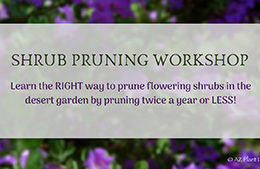Well, here is the post that I have been promising you all winter long. Are you ready to begin spring pruning? Okay, let’s get started…..
Those of you who have read my blog for any length of time have come to learn that I absolutely abhor formal pruning of flowering shrubs. I have posted about it twice and you can read more – Shrubs Aren’t Meant To Be Cupcakes and Read The Label Or You Might End Up With Cupcakes if you like.
First, we will start with the Bad (and ugly) – I am warning you, the following photos are not pretty. They show the results of formal pruning over time.
Feathery Cassia (Senna artemisiodes) Dead areas are a result of repeated shearing of the shrubs.
Texas Sage, sheared repeatedly, resulting in more dead then live wood.
Texas Sage ‘Green Cloud’ (Leucophyllum frutescens ‘Green Cloud’) Over the years, this flowering shrub had been sheared resulting in dead growth.
The following photos are not necessarily ugly but are examples of formal pruning that leads to the problems pictured above over time as well as higher maintenance.
White Texas Sage shrubs, pruned as cupcakes.
Chihuahuan Sage (Leucophyllum laevigatum) formally pruned and rapidly outgrowing its space.
Dwarf Oleanders (Nerium oleander)
As I have mentioned before, I am not against formal pruning when it is done to plants that specially suited to it such as Dwarf Myrtle, Boxwood, and others. However, formal pruning of flowering shrubs shouldn’t be done for many reasons, including:
– It removes the flower buds, severely curtailing the number of flowers that bloom.
– Causes the shrub to constantly work to replace the leaves that were removed, which causes stress to the shrub and ultimately shortens it’s life.
– Increases the maintenance required because of frequent pruning, which means more material is hauled off to the landfill as well as a higher landscape bill.
– Over time, repeated shearing causes branches to die off due to lack of sunlight reaching the interior of the shrub.
– The shrubs requires more water because it is constantly having to regrow what was removed.
– And lastly, creates a generic looking ‘blob’ in the landscape where a beautifully shaped and flowering shrub should be.
Okay, now some of you may have shrubs that look like some of these. But, don’t worry…there is hope and the solution is really quite simple. What they need is to be severely pruned back. This type of pruning is called “Severe Renewal Pruning.”
Now, I do need to warn you…many of us are familiar with the concept that beauty comes at a price. Well, there is a price to be paid in order for shrubs to look their best and show off their stuff and it requires an Ugly stage.
WARNING…the following photos are not pretty.
Severely pruned Texas Sage in spring
Severely pruned Dwarf Oleander
Okay, I warned you….but this is what you want your shrubs to look like after you are done pruning. I realize that all that is left are bare branches sticking up from the ground…BUT THIS IS GOOD!
Severe pruning like this removes old wood, which become unproductive over the years and does not produce as many leaves or flowers. It also stimulates new growth in the form of new branches that will produce more leaves and flowers. It also keeps the size of the shrub in check by reducing the size periodically and decreasing the amount of pruning needed later on.
Now, this type of pruning does not need to be done each year…I actually recommend doing this every 3 years or so.
Texas Sage 4 weeks after pruning
I won’t lie and say that the ugly stage disappears right away, but in 4 – 8 weeks, you will rewarded with new growth that will rapidly cover the bare branches.
**There is a chance that your shrubs will not recover from severe pruning. However, that is usually an indicator that they would not have survived for long if you had done nothing. So, you really have nothing to lose and everything to gain by pruning your plants this way every few years – you may easily add years on to the life of your shrub and dramatically increase their health and beauty.
Okay, I have covered the bad and ugly. Now for the good and beautiful…
Texas Sage ‘Green Cloud’ (Leucophyllum frutescens ‘Green Cloud’)
Desert Senna (Senna artemisiodes sturtii)
‘Rio Bravo’ Sage flower
‘White Cloud’ Texas Sage Flower
These beautiful photos should be reason enough to stop formally pruning your flowering shrubs. So, put down your hedge pruners. All you will need in the future are hand-pruners and loppers.
You may be wondering when should I prune my flowering shrubs? Well, Texas Sage and all Leucophyllum species can be severely pruned back in March as well as Oleanders. I do not recommend pruning them back severely in the summer months as they may not be able to grow back while dealing with the stress of the heat. Alternatively, do not prune in the fall or winter as you will have naked branches for a long, long time and new growth that does appear will be very susceptible to frost.
Cassia species should be pruned back once they have finished flowering, which is usually in late spring.
When it comes to pruning, a good rule of thumb is to prune less frequently, but when you do, prune back more severely.








The Good…The Bad….And The Ugly
desert gardeningWell, here is the post that I have been promising you all winter long. Are you ready to begin spring pruning? Okay, let’s get started…..
Those of you who have read my blog for any length of time have come to learn that I absolutely abhor formal pruning of flowering shrubs. I have posted about it twice and you can read more – Shrubs Aren’t Meant To Be Cupcakes and Read The Label Or You Might End Up With Cupcakes if you like.
First, we will start with the Bad (and ugly) – I am warning you, the following photos are not pretty. They show the results of formal pruning over time.
Feathery Cassia (Senna artemisiodes) Dead areas are a result of repeated shearing of the shrubs.
Texas Sage, sheared repeatedly, resulting in more dead then live wood.
Texas Sage ‘Green Cloud’ (Leucophyllum frutescens ‘Green Cloud’) Over the years, this flowering shrub had been sheared resulting in dead growth.
The following photos are not necessarily ugly but are examples of formal pruning that leads to the problems pictured above over time as well as higher maintenance.
White Texas Sage shrubs, pruned as cupcakes.
Chihuahuan Sage (Leucophyllum laevigatum) formally pruned and rapidly outgrowing its space.
Dwarf Oleanders (Nerium oleander)
As I have mentioned before, I am not against formal pruning when it is done to plants that specially suited to it such as Dwarf Myrtle, Boxwood, and others. However, formal pruning of flowering shrubs shouldn’t be done for many reasons, including:
– It removes the flower buds, severely curtailing the number of flowers that bloom.
– Causes the shrub to constantly work to replace the leaves that were removed, which causes stress to the shrub and ultimately shortens it’s life.
– Increases the maintenance required because of frequent pruning, which means more material is hauled off to the landfill as well as a higher landscape bill.
– Over time, repeated shearing causes branches to die off due to lack of sunlight reaching the interior of the shrub.
– The shrubs requires more water because it is constantly having to regrow what was removed.
– And lastly, creates a generic looking ‘blob’ in the landscape where a beautifully shaped and flowering shrub should be.
Okay, now some of you may have shrubs that look like some of these. But, don’t worry…there is hope and the solution is really quite simple. What they need is to be severely pruned back. This type of pruning is called “Severe Renewal Pruning.”
Now, I do need to warn you…many of us are familiar with the concept that beauty comes at a price. Well, there is a price to be paid in order for shrubs to look their best and show off their stuff and it requires an Ugly stage.
WARNING…the following photos are not pretty.
Severely pruned Texas Sage in spring
Severely pruned Dwarf Oleander
Okay, I warned you….but this is what you want your shrubs to look like after you are done pruning. I realize that all that is left are bare branches sticking up from the ground…BUT THIS IS GOOD!
Severe pruning like this removes old wood, which become unproductive over the years and does not produce as many leaves or flowers. It also stimulates new growth in the form of new branches that will produce more leaves and flowers. It also keeps the size of the shrub in check by reducing the size periodically and decreasing the amount of pruning needed later on.
Now, this type of pruning does not need to be done each year…I actually recommend doing this every 3 years or so.
Texas Sage 4 weeks after pruning
I won’t lie and say that the ugly stage disappears right away, but in 4 – 8 weeks, you will rewarded with new growth that will rapidly cover the bare branches.
**There is a chance that your shrubs will not recover from severe pruning. However, that is usually an indicator that they would not have survived for long if you had done nothing. So, you really have nothing to lose and everything to gain by pruning your plants this way every few years – you may easily add years on to the life of your shrub and dramatically increase their health and beauty.
Okay, I have covered the bad and ugly. Now for the good and beautiful…
Texas Sage ‘Green Cloud’ (Leucophyllum frutescens ‘Green Cloud’)
Desert Senna (Senna artemisiodes sturtii)
‘Rio Bravo’ Sage flower
‘White Cloud’ Texas Sage Flower
These beautiful photos should be reason enough to stop formally pruning your flowering shrubs. So, put down your hedge pruners. All you will need in the future are hand-pruners and loppers.
You may be wondering when should I prune my flowering shrubs? Well, Texas Sage and all Leucophyllum species can be severely pruned back in March as well as Oleanders. I do not recommend pruning them back severely in the summer months as they may not be able to grow back while dealing with the stress of the heat. Alternatively, do not prune in the fall or winter as you will have naked branches for a long, long time and new growth that does appear will be very susceptible to frost.
Cassia species should be pruned back once they have finished flowering, which is usually in late spring.
When it comes to pruning, a good rule of thumb is to prune less frequently, but when you do, prune back more severely.
Spring Cleaning in the Garden – Prune Away Frost Damage
Arizona garden, ShrubsAlthough I greatly enjoy being able to grow many frost-sensitive plants such as Bougainvillea and Arizona Yellow Bells (Tecoma stans), I do not particularly like how they look in the winter, once frost has hit our area – zone 9a.
And so, when hints of spring are in the air….I am itching to get back into the garden to prune them back. In our area (the Phoenix metro area), this is generally the beginning of March which is usually after the last frost has occurred in our area.
First on my list is the Bougainvillea. I have three in my back garden.
Not too attractive is it? You can clearly see where the frost damaged the top growth. The bottom growth is still green as the top branches protected them from frost damage.
Now you would assume that you just cut back all the leafless branches, but DON’T. Many of the naked branches are still alive. Look closely at the branch below and you can see that the part of the branch on the left is brown with no hint of green – prune the brown part of the branch off, leaving the green shaded part alone.
You can also look and see tiny leaflets starting to emerge. This is also a sign to look for when determining what part of the branches to prune.
Why not prune earlier to remove the ugly, naked branches you may ask? Well, the answer is simple….if you prune too early and frost hits your area, it will damage the newly emerging leaves and could easily kill the live tissue inside of the branches, leaving you with a much smaller plant or a dead one. So, as ugly as it looks in the winter….leave it alone, please?
Spring Pruning
All finished! Okay, I admit, that it still does not look all that attractive and many may feel compelled to remove all of the naked branches. But, look closely below….
Spring Pruning
This is why you do not want to remove all of the naked branches. This is my Bougainvillea one week after pruning. Beautiful leaves are beginning to grow out from those formerly naked branches.
**Tips for pruning Bougainvillea…WEAR LONG SLEEVES to protect yourself from the thorns. I used hand-pruners and loppers to prune all of my shrubs.
I am working hard today at pruning back many of my other desert shrubs and will be posting about them this coming week, so please visit again :^)
Peacful Day and Spring Pruning…
Refuge in the Desert
California, California desert garden, desertFor those of you who have read my blog from time to time, you have already met some of the members of “The Refuge” and seen glimpses of their gardens.
Today, I would like to take the opportunity to introduce to all of the residents and show you more of their garden and the beautiful desert that surrounds them.
The Refuge is a beautiful, green oasis, located in the California desert, near Palm Springs. Stark, beautiful, desert mountains surround them that are often covered in snow in the winter.
It does rain in the desert and is always a time of celebration. Dry desert washes, are suddenly filled with running water.
In the middle of this desert are the home and gardens of my sister and her family.
Peach Tree Blossom
In the middle of the desert, you will find life in this desert garden.
Yellow Daisy (Euryops pectinatus)
Flowers are lovingly grown by my sister, Daisy Mom.
Cape Honeysuckle (Tecomaria capensis)
Vegetables are grown by my nephew, Mr. Green Jeans.
My sister and niece, Fruity Girl, also lend a hand to the vegetable garden.
A large Mesquite tree graces the front garden….
And if you look closely, you will often find one of the residents of “The Refuge” high up in the tree.
We have heard from Mr. Compost, my brother-in-law, about how why we should compost and his guest post can be read here.
All that is left for me to do now is to introduce you to the supporting cast, which includes, Gimli, who is the son of my dog.
Missy….and their shy cat.
The beauty of the surrounding desert, the gardens of “The Refuge” along with it’s residents make this a very special place to visit.
There is so much that I am looking forward to sharing with you…we will visit the vegetable garden in depth and view more of the beautiful flowers that my sister grows.
We will also be going on a field trip to see a wind farm which is located close by “The Refuge”.
As the seasons change, we will be visiting the garden to see the changes that they bring.
Thank you for visiting “The Refuge” with me.
Signs of Spring in February
AgaveAlthough it is still technically winter here in the desert, the signs of spring are everywhere….
The plum tree at Double S Farms begins to flower.
Earlier this week, I noticed the plum tree that sits in front of the house at Double S Farms, is just beginning to unfurl it’s flowers. I cannot wait to have some of my mother’s plum preserves in a few months :^)
Yesterday, I traveled up to an area north of Fountain Hills, AZ, which is approximately a one hour’s drive from my home. It is also the place where I worked for over 5 years. I was asked to do a landscape consultation for a client and so I brought my camera along to see what signs of spring I could capture in the surrounding area.
I went for a drive on one of the golf courses that I used to work on and immediately headed for one of my favorite places. This area of the golf course borders the desert, with only a barbed wire fence separating the natural desert from the golf course.
The desert was lush and green as a result of the winter rains we have received. Snow can be seen melting from the top of Four Peaks Mountain in the distance.
Flower buds are beginning to form at the tips of the Buckhorn Cholla.
Tiny blue flowers grace this Rosemary shrub.
Next, I went on a drive around the beautifully landscaped homes and took pictures of the plants that were in flower.
Threadleaf Cassia (Senna nemophila)
Cassia shrubs, a favorite Australian native of mine, are beginning to flower showing off their bright yellow blossoms.
Trailing Indigo Bush (Dalea greggii)
Tiny purple petals are just beginning to peek out from the Trailing Indigo Bush. Their vibrant purple color contrast so beautifully with the gray-green leaves of this groundcover.
Sweet Acacia Tree (Acacia farnesiana)
This native desert tree is encased in fragrant, golden puffball flowers.
Octopus Agave (Agave vilmoriniana)
This Octopus Agave, which I planted years ago, is working towards achieving it’s crowning glory – rapidly growing it flowering stalk, which will produce hundreds of new ‘baby’ agave plants. Once it has finished flowering, it will die.
Gopher Plant (Euphorbia glandulosa)
An ugly common name, graces this beautiful succulent plant. In spring, they are covered with vibrant, chartreuse colored flowers.
Valentine Shrub (Eremophila maculata ‘Valentine’)
I would like to finish this post by showing you a photo that I took yesterday of my favorite shrub, Valentine. They were in full-bloom yesterday and it was obvious that they are my favorite as they were present in most landscape areas that I had designed years ago.
Thank you for allowing me to show you some of the beautiful plants that I have been so blessed by seeing this week. This is such a wonderful time of the year in the desert and it isn’t even spring yet!
As winter ends and spring begins, there will be more to see….wildflowers, flowering Palo Verde trees, cactus flowers and much more!
Early Signs of Spring on the Farm….
Herbs and Succulents on the Farm
desertThis is my last post about my visit to “The Farm at South Mountain”, which is a rural oasis just minutes from downtown Phoenix.
The farm has much to offer it’s visitors….organic vegetable & flower gardens, award-winning restaurants, large picnic areas underneath a pecan tree grove, artist studio and gift shop plus much more.
Table of herbs available for sale behind white flowering Geraniums.
Today, I would like to show you some of the herbs and succulent plants that I found.
The bright blue flowers of Rosemary.
Oregano
My brother-in-law and sister (residents of “The Refuge”) checking out the herbs and vegetables offered for sale.
This collection of hats has nothing to do with herbs or succulents, but I just loved how they were hanging on the wall. Imagine how much use the tattered hat has seen :^)
A table filled with Ponytail Palm, Sanseveria, Jade and many other succulents, available for $5 each.
Succulent plants
Indian Fig Prickly Pear (Opuntia ficus-indica)
Although from all appearances, this farm could be located anywhere, a Indian Fig Prickly Pear cactus (above) shows the farm’s desert roots.
It was a wonderful day and I cannot wait to visit again. Below are a few more views of the farm before we leave….
Stop and sit for awhile and listen to the radio.
Chilis
An African Sumac (Rhus lancea) tree shades the patio of the cafe.
Thank you for sharing my visit to the farm and for all of your friendly comments.
Flowers From a Farm in the City…
Flowers From a Farm in the City…
AZ Plant LadyYesterday, I wrote about a visit to “The Farm at South Mountain”, which is an old farm that is a rural oasis in the shadow of downtown Phoenix.
The farm is made up of organic flower and vegetable gardens, restaurants, a large pecan grove picnic area, artist studio, gift shop, farmer’s market and spa. Weddings are also held here in this beautiful place.
As lovely the pecan grove looks in the winter, I plan to return in the summer to see them fully leafed out, so I can enjoy a picnic lunch in their shade.
Sweet Columbine
Although the vegetable gardens were most prominent gardens to view, flowers could be found planted in mass, such as daisies and calendulas. But, I delighted in finding the flowers that were tucked away in unexpected places.
Vibrant, Red Ranunculus
Although, I do like vegetables, I am a flower girl at heart and so, I had so much fun looking here and there making sure that I did not miss any flowers.
Gerber Daisies grace the front of a collection of flowers.
Some flowers such as the Ranunculus and the Columbine, are not often seen in gardens in our area, and so I was happy to be able to take pictures of them to add to my photo library.
Spanish Lavender (Lavendula stoechas)
Do any of you have a flower or plant that you just love but for some unknown reason, you have not included it in your garden? Well, I love lavender and do not have any in my garden. Note to self…I need to plant some lavender ;^)
Heliotrope, Gerber and Purple Daisies.
Like I said before, you never know where you will find flowers. This laundry basket had a few cans full of flowers just sitting off to the side.
Bright, Sunny Calendula Flower.
Calendulas grew in organized mass plantings alongside the vegetables.
Fruity Girl (resident of “The Refuge”) peruses the flowers, herbs and succulents for sale.
Violas and Alyssum
Lupine
Candytuft
Years ago, I grew Candytuft with Purple Coneflower. I love the brightness of the white color of the Candytuft.
More Violas
Rows of Geraniums.
Geraniums perform very well in the desert, but generally do not survive the summer heat. So, they are best treated as a winter-annual in the desert.
Valentine shrub with Geraniums.
Little Farmer, Pastor Farmer, Fruity Girl, Mr. Compost, Daisy Mom and Monkey Boy.
I enjoyed visiting this special place with my younger sister and her family (residents of “The Refuge”). My mother, Pastor Farmer and nephew Little Farmer, (residents of Double S Farms) also came.
The Farm at South Mountain is a wonderful place to visit. I can hardly wait to visit again in the summer with my husband and kids when they will have summer flowers for us to see :^)
Tomorrow, will be my last post about this special place….
An Old Farm in the Middle of the City
Vegetable GardeningLast Friday, I went on a visit to a very special place, called “The Farm at South Mountain”. The farm is a rural oasis just 8 minutes from downtown Phoenix.
My younger sister and her family (residents of “The Refuge”), were in town on a visit and we all journeyed together to explore this peaceful farm.
The 12-acre farm sits on an old riverbed and is blessed with rich soil. A large pecan grove, organic vegetable and flower gardens, 3 award-winning restaurants, gift shop, artist studio and spa are all located on the farm. Entry to the farm is free and guests are encouraged to enjoy the tranquil beauty of the farm.
As you first enter, you are greeted by the large pecan grove with numerous picnic tables, inviting you to enjoy breakfast or lunch from one of the restaurants on-site. The pecan trees hide the sights of the skyscrapers of downtown Phoenix and make you feel like you are miles away from the city.
*Even in winter, I think pecan trees are beautiful.
The organic gardens greet you as you walk along the walkways. Rows of vegetables and flowers were neatly laid out. Roosters could be heard before you could see them nearby the vegetable gardens.
Organically grown vegetables, flowers and herbs surrounded us everywhere we looked. I felt like a kid in a candy store – there was just so much to see and take pictures of.
A farmer’s market is held on Saturday mornings at the farm.
Young tomato plants.
Anaheim Chilis
The vegetables grown on the farm make their way to local restaurants, schools and markets.
Brocciflower, freshly harvested.
Tomatoes
Carrots and turnips freshly washed.
Green and purple lettuce washed and packaged and ready to leave for a local restaurant.
No need to purchase natural fertilizer, with a ready supply available from the chicken coop.
Huge broccoli plants.
Purple and Green Lettuce.
I love the contrast in the colors of the green and purple lettuce.
How is this for a compost pile?
Daisy Mom, Fruity Girl, Little Farmer and Pastor Farmer. (Residents of “The Refuge” & “Double S Farms”).
We enjoyed a wonderful morning together and ended it with a picnic lunch underneath the pecan trees.
There was so much to see and I took over 118 photos. But, don’t worry, I won’t make you look at all of them ;^)
But, I would love to share pictures of the flowers and the herbs and succulents in my next post with all of you. They were just beautiful.
A Simple February Bouquet….
AZ Plant LadyI find joy in the simple things and that includes my garden as well.
Yesterday, as I was preparing for my daughter’s 12th birthday party, I realized that I wanted to have a vase full of flowers to decorate the table. I had no time to go to the store, so I ran outside and clipped some blooms from my flowering shrubs and one of my vines.
The flowers of Desert Senna, Globe Mallow and Purple Lilac Vine.
Although, there were not too many plants blooming, I was happy to have found three types of flowers that would look nice together in a bouquet.
Yes, my bouquet was simple and decidedly un-formal, but that describes me perfectly. I was pleasantly surprised at how easy it was to bring my blooming garden inside.
And so…I plan to create a simple bouquet from the flowers of my garden each month. I am looking forward to seeing how my bouquets will change as my garden changes through the months.
Anyone care to join me? Even in winter, small branches from a flowering fruit tree or witch hazel would be beautiful.
Three Neglected Peach Trees…
Double S FarmsA few weeks ago, my brother-in-law asked me to come out to the family farm (Double S Farms) asked me to come over and help him to prune their numerous fruit trees. I had been wanting to work on them because they had been sorely neglected by the previous owners of the farm.
Family farm
These three peach trees produced a large amount of fruit that we all enjoyed last summer. However, they had been badly pruned over the years and their branches reached so high into the sky, that it was impossible to reach all of the fruit.
Why did we decide to prune them you may ask? Well, besides the fact that they had been disfigured by bad pruning, the other benefits would be numerous. There would be increased fruit production, strengthened trees, earlier fruit production and easier maintenance.
Our tools – Loppers, Pruning Saw, Hand Pruners and Pole Saw.
The two types of pruning cuts that we used were thinning and heading cuts. The first type – thinning cuts, removes branches back to the larger branch they are growing from. So, we concentrated on removing all crossing branches and those growing into the center of the tree. We did this because peach and plum trees should have an open center.
The second type of cut we used – heading back, removes part of the branch, pruning back to a outward facing bud. So we made sure that our cuts, were pruned back to an outside facing bud and cut at a 45 degree angle.
Farmer Dad, working hard making a thinning cut with a pruning saw.
Pruning should be done while the trees are still dormant, which is January here in the desert.
Since dwarf forms of peach trees do not exist, pruning is the only way to shorten the tree in order to reach the fruit and also to be able to fit a net over the tree to protect them from the birds eating the fruit. Unfortunately, a lot of fruit was lost to the birds last year.
Family farm
As we pruned, evidence of bad pruning was evident. The photo above shows an incorrect pruning cut, while the bottom one is the right way to prune. You want to prune back to the trunk to the branch collar.
Peach and plum trees can take heavy pruning, but we removed only 20% of the trees branches. Next year, we may do more if needed. We felt that is was better not over-prune and stress the trees.
You can tell why it is important to prune back to the branch when you see how the cut branch above died back because it was not pruned close enough to the branch it came from.
Once we were finished with the peach trees, we started on the two apple trees in the backyard. Both of these trees were better maintained and so we removed a few of the lower branches and made some heading cuts.
Pruning cuts back to the trunk. You can see the branch collar, which is a specialized area that surrounds branches. Do not cut the branch collar, but make your pruning cut just before.
Making heading cuts to the apple tree.
Apple trees only require light pruning. They have a different shape then peach trees and do not have an open shape. Rather, they should have many interior branches. So, the majority of pruning we did were some heading cuts and just a few thinning cuts.
You know, there is just something so fulfilling after spending the day pruning and seeing the instant results of your work. A couple of weeks later, I took the following pictures of the now flowering trees we had pruned.
Peach blossoms reach towards the sky.
The apple trees are now covered in blossoms.
Next year, we will probably do some additional corrective pruning for the peach trees in order to further fix the damage done by the previous owners. But for now, we are sitting back and enjoying their beauty and looking forward to peach jam and apple butter this summer.
Special Delivery….
AZ Plant LadyGuess what came in the mail today? Believe me, you’ll never guess…
Baby Chicks!
Isn’t amazing that they send them in the mail?
These baby chicks are only 3 days old. They can live for up to two days without food or water since they continue to live off the nutrition received from the yolk. So, that makes it feasible to send them in the mail.
These baby chicks are the newest residents of Double S Farms. Chicken Farmer, my sister, has everything all ready for them.
She wrote about her preparations in an earlier post “A Pair of Boots and an Empty Chicken Coop”.
Buff Orpington chick
Barred Plymouth Rock chick
Their names are Flo, Effie, Ramona and Lucy.
The chicks will spend the next 6 weeks in their brooder, above.
But soon, they will be moving into their new custom-made chicken coop.
We are all looking forward to fresh eggs…